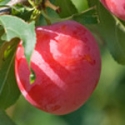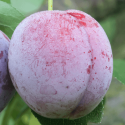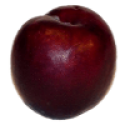Can YOU Really Grow A Plum Tree
HERE In North Florida?
You Betcha!
If there's only room for one tree,
and you live here in Zones 8b-9b-10a >>>
then We Recommend:
Scarlet Beauty Plum: Prunus "Scarlet Beauty"
. . . one of the best self-pollinating plums for our mild climate.
That means you can have fruit with just one tree.
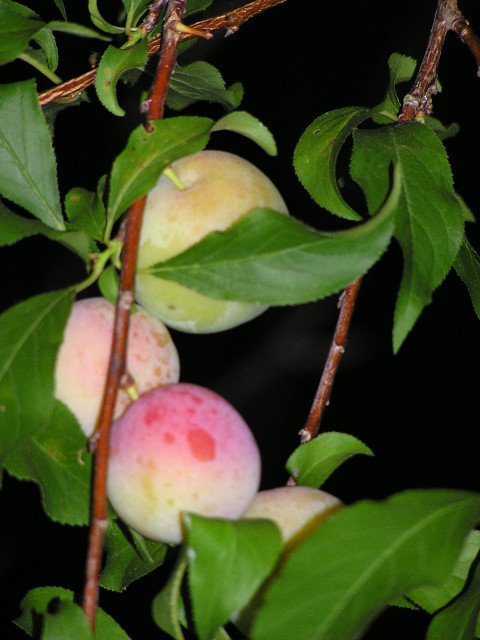
Here's proof from our gardens! This is what the fruit looks like in April, about 2-3wks b/4 it's ripe.

Scarlet Beauty is one of the first plums of the season to ripen, approximately early May.
Order larger sizes below:
Bearing age trees in
7g & 15g available
The Scarlett Beauty is a very early blooming, low chill, Japanese style plum with bright red skin and scarlet streaked flesh. It has medium sized fruit with excellent flavor and softens rapidly. Very heavy bearing.
When grown organically, it has excellent flavor and is very juicy. Generally this is a sweet-slightly-tart fruit. If allowed to fully ripen on the tree, fruit becomes wine colored, and flavor turns exceptionally sweet. While many of the fruits are about 1.5-1.75" in diameter, we've had some mature to 2" in size when given enough food and water in the weeks leading up to harvest.
And while it is truly a self pollinating variety, it generally produces even more if cross-pollinated. Another Scarlett Beauty or even the native Chickasaw plums make good pollinators.
It requires only 150 chill hours and is well suited to zones 8b-9, and even zone 10a. (Some nurseries also include zone 7, but that's a bit too cold most winters.)
approx 5' tall / 5/8" calipers (trunk size) / 3gal pots
Here in Zones 8b-9 - 10a >>>
We Also Recommend:
More Japanese Plums: Prunus spp varieties
. . . while some of these varieties are said to be partially self fertile,
most varieties require a pollinator from another variety
and all will show increased harvests from having a second (different) tree nearby.
Japanese plums are a development of the breeding programs initiated by the famed botanist Luther Burbank from Santa Rosa California. As a general rule they do much better in warm climates than their European counterparts. Most require 700 to 1000 hours in the chilling range to trigger blooming, but there are now a number of varieties perfectly suited to Florida in the range of 100 to 500 chill hours.
These Japanese plum varieties are under current cultivation with the local growers and are all excellent choices for Florida, but some have geographical limitations within the state:
- Scarlett Beauty -- bright red, sweet-tart; or all sweet if wine-red;
- Methley Plum - purpley-red, mild;
- Lee's Yellow -- sweet
- Lee's Red -- sweet red
- Bruce -- sweet, wine-red
- Santa Rosa -- sweet, reddish-purple
- Laroda -- sweet black plum
- Catalina -- sweet black / 250 chill
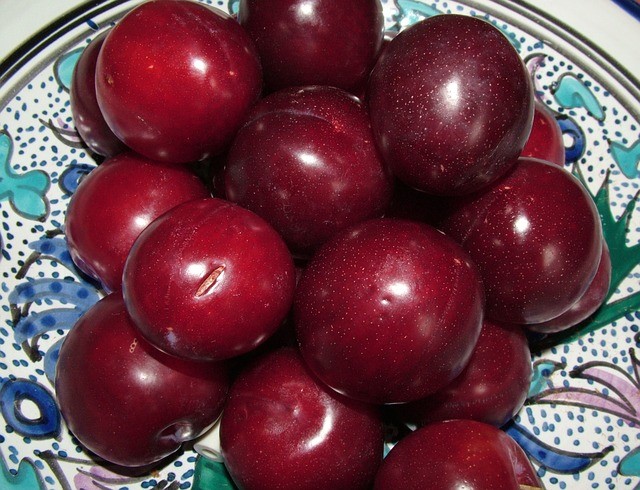
Scarlett Beauty, Methley Plum, Bruce, Gold, Lee's Yellow, and Santa Rosa are all excellent choices for Florida but each have geographical limitations.
Methley Plum: Prunus "Methley"
for zones 5-9b
Methley is a popular, semi-self-pollinating, purpley-red skinned plum that blooms late but ripens early in June in Florida.
Methley is a heavy producer of clusters of juicy, sweet, mild flavored plums. Fruit is medium to large sized and has a red flesh interior.
Because of its bloom time, Methley makes an excellent pollinator for most of the other Japanese type plums.
At only 250 chill hours or less, it is suited to much of zone 9, yet is cold hardy almost to zone 5. It is a vigorous growing tree and quite disease resistant.
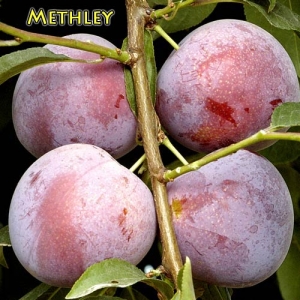
photo courtesy Dave Wilson Nursery
And For Our Colder Winters (in North Florida)
for zones 8b & 9a:
Santa Rosa Plum: Prunus "Santa Rosa"

This extremely popular Luther Burbank original is one of the later ripening varieties for North FL.
It generally ripens closer to mid July, maybe even as late as early August. It is semi- self pollinating, but it produces a much more reliable and bountiful harvest when paired with either the Bruce plum or the Gold plum.
Medium to large sized, freestone, reddish-purple, with firm red flesh. It requires a minimum of 400-500 chill hours to set fruit consistently, though sometimes fruits otherwise. Zones 8b to 9a would be about as far south as this variety would thrive. Plant as far south as Brooksville.
Santa Rosa plum trees grow to about 12 feet tall at maturity
Order larger sizes below:
Bearing age trees in
7g & 15g available
Best pollinators for the Santa Rosa:
use Bruce & Gold for zone 8b, use Methley or Laroda for zone 9a.
Bruce Plum: Prunus "Bruce"
Bruce Plum is a prolific producer of large, very juicy wine-red fruit, on a medium sized tree -- approximately 12' tall at maturity. It is a hybrid of a Japanese variety and our native Chickasaw plums.
Plums are juicy-sweet enough to eat fresh from the tree, and yet firm enough for canning. Bruce requires 400-500 chill hours.
Note: our winter 2019 registered only 406 chill hours, and the Bruce plum trees set fruit; appears to have cross-pollinated with the Laroda black plum.
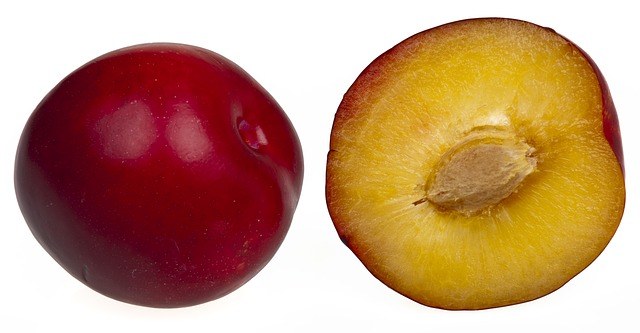
Bruce is wine-red outside with a yellow flesh
Order larger sizes below:
Bearing age trees in
7g & 15g available
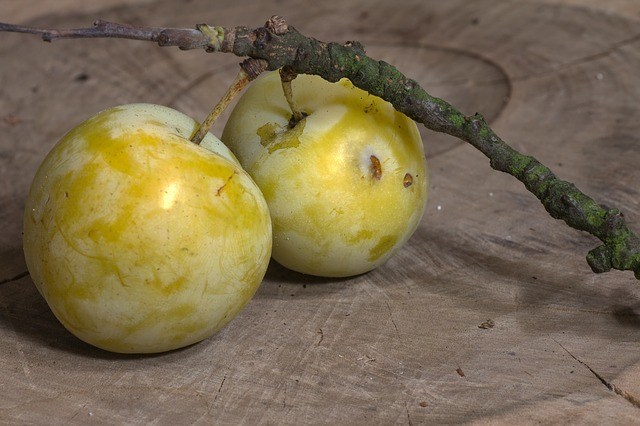
Gold Plum is not the same as the dwarf Gulf Gold, nor is it the same as Lee's Yellow.
Gold Plum: Prunus "Gold"
GOLD PLUM is a well-known, old Southern variety that has been a prolific producing backyard orchard plum. Naturally develops a very large, wide canopy.
Gold requires a minimum 400 chill hours and works well in Alachua County down to Brooksville area, Ocala and the like. Also does well to the north & west of Alachua County. Grows in zones 5-9a.
Gold Plum is a large, richly sweet-sour flavored plum that is green to yellow-gold and highly aromatic. A fully ripe Gold becomes more golden, is soft to the touch, and the sour flavor is more subtle.
Fruits ripen in late May to early June.
UPDATE FOR 2023:
Scarlett Beauty is most abundant in super 7g & 15g sizes;
Lee's Yellow is available in super 7g & 15g; Lee's Red is available in super 15g;
Santa Rosa and Bruce in 15g -- ltd qty; Laroda available in 15g; Catalina in super 7g;
No Methley or Hypoluxa for spring;
Burgundy plum coming for May 2024
4gal
1yr+ to fruit
5-6' tall / trimmed
- first level of branching
- 3/8-1/2" trunks above the graft
$29ea
7gal
beginning to fruit
approx 5.5-6' tall
- about 2' spread
- 3/4" trunks above the graft
- "de-leadered" i.e. properly pruned for optimal shaping
$49ea
limited availability
super7gal
good fruiting age
approx 6-6.5' tall:
trimmed
- nicely branched about 3' spread
- 1" trunks
above the graft
$69ea
15gal
heavy fruiting
huge specimens
7.5'+ tall / trimmed
- well branched:
about 4' spread - 1.25" trunks above the graft
$99ea
super 15gal
serious bearing age
7.5-8' tall / trimmed
- well branched:
about 5' spread - 1.5" trunks above the graft
$135ea
limited availability
If you live in Zone 8b, 9a or 9b:
We recommend growing 2-3 varieties of plums to accommodate the variety in our winters. Milder winters will result in the Scarlett Beauty bearing prolifically, while the Santa Rosa will thrive on much colder weather. In severe winters, the Santa Rosa & Bruce combo will produce the most fruit here.
Understand that young trees will not do as well with the weather extremes as more established trees. You may lose a Scarlett Beauty altogether if you plant it and get very late freezes the very first year it blooms. On the other hand, a more established Scarlett Beauty will survive well, but not have much fruit if at all that year.
But since you also planted a Methley or a Santa Rosa, you'll have a great crop of plums anyhow! Good for you!
Other Varieties Available:
'Hypoluxa' Plum: Prunus "Hypoluxa"
. . . another terrific self-pollinating plum for our mild climate.
That means you can have fruit with just one tree.
Hypoluxa is a little known variety of European plum that does well in the Central & North Central FL landscape.
At just 200 chill hours, Hypoluxa is another low chill variety, perfect for the lower half of zone 9 planting. It is a purple-red skinned, medium sized plum that is generally one of the first plum of the season to ripen, very early in May, close to the same time as the Scarlet Beauty. Red flesh with lots of juice and quite sweet tasting.
What's neat about the European plums, is they are generally sweeter than the Japanese plums, hold on the tree a bit longer, and last longer after picking -- that is, if you can resist eating them. And Hypoluxa is no exception: the skin is sweeter and not 'tough' like the older or more traditional varieties of Japanese plums like the 'Gulf' series of plums.
That said, Hypoluxa makes a great compliment to the Scarlett Beauty. It's a more purply color, slightly different flavors, and ripens two weeks sooner, effectively extending your harvest season for longer when you plant both.
sorry, but supply is extremely limited for Hypoluxa at this time: please call us for details if you're interested in this one.
Hope to have these for fall 2023.

